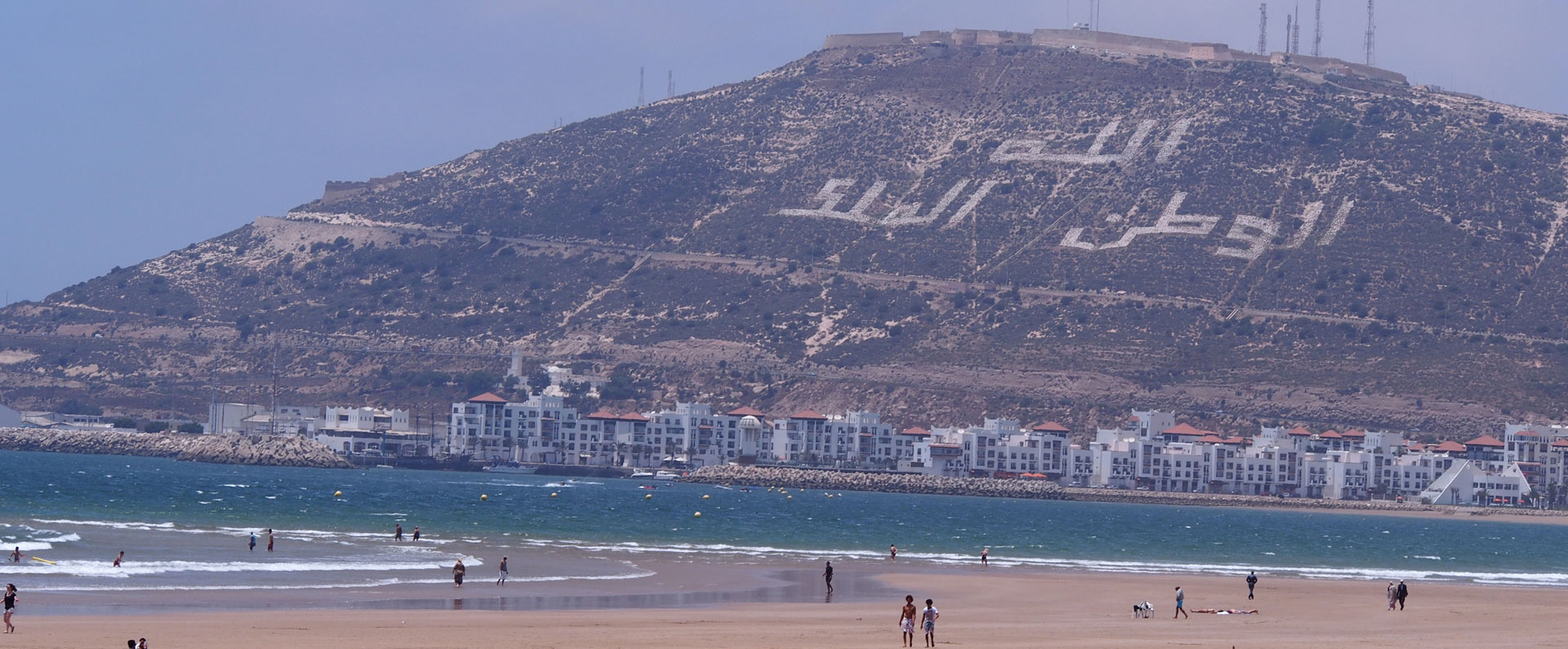Agadir is a major city in mid-southern Morocco. Agadir is located on the shore of the Atlantic Ocean near the foot of the Atlas Mountains, just north of the point where the Sus River flows into the ocean. It is 508 km south of Casablanca. It is the capital of the Agadir Ida-U-Tanan Prefecture and of the Sus-Massa economic region. A majority of its inhabitants speak Tashelhit Berber, one of the varieties of the Berber language.
Etymology
The name Agadir is a common Berber noun agadir meaning “wall, enclosure, fortified building, citadel”. This noun is attested in most Berber languages, and may be a loanword from Phoenician-Punic, a Semitic language spoken in North-Africa until the fifth century CE.
There are many more towns in Morocco called Agadir. The city of Agadir’s full name in Tashelhit is Agadir n Yighir, literally “the fortress of the cape”, referring to the nearby promontory named Cape Rhir on maps (a pleonastic name, literally “Cape Cape”).
A single male inhabitant or native of the town is known in Tashelhit as a gg ugadir (also a common surname, “Gougadir” in French spelling), plural ayt ugadir “men of Agadir” (also collective name, “men and women of Agadir, people of Agadir”); a single feminine inhabitant is a ult ugadir “woman of Agadir”, plural ist ugadir “women of Agadir”. In Moroccan Arabic, an inhabitant is a agadiri, plural agadiriyin, feminine agadiriyat, plural agadiriya.
History
The origin of this name is not entirely known. Agadir GeschiedenisHowever there may be some link to a fort built by a Portuguese merchant north of town in the year 1505. It was later owned by King Manuel I of Portugal, who changed it into a garrison city. It was the time when the Agadir port was a major port on the sea towards Sudan and Guinea.
In 1541 it was captured by the Irish Saad. However, in the 17th Century it was under the control of Berber Kingdom of Souss and later was conquered by Moulay Ismail which was the golden era of Agadir. Sisi Abdellah Mohammed closed the port and founded the new Essouira, which saw its glory weaning.
In 1911 the Agadir Crisis between France and Germany led to France bringing a protectorate over Morocco. The worst moments of the city were the 15 seconds on the midnight of February 29, 1960 when an earthquake destroyed the whole city killing thousands. It destroyed the entire ancient Kasbah. However the destruction was taken as a challenge by King Mohammed V of Morocco to rebuild the city. Agadir was rebuilt 3 kms south of the original site.
Modern Agadir
Agadir is a fine modern city now with wide avenues, blooming gardens, superb hotels, first grade airport and a magnificent port. Other than this the first attraction for the tourists are the splendid beaches lined with lively resorts. The beaches are the most popular with the town lacking typical tourist attraction like museums, ancient monuments etc.
However, you can have a great stay at one of the hotels in town and take day trips to some interesting sites nearby. You would find the cliff road that flanks the old Kashbah of the 16th century and overlooking the pristine blue waters of the oceans very interesting. The colorful valleys of the Great Souss and the slopes of the majestic Anti-Atlas are a must visit.
The kingdom of Morocco is blessed with bright sunshine for about 300 days of the year. Adagir beaches are the perfect location to catch some sun, go sailing, wind surfing, horse riding or simply lounge in the shade of the Eucalyptus around here. There is nothing as refreshing as watching the beautiful blue waters of the ocean, sipping a fresh fruit cocktail with the mild smell of the Eucalyptus.


